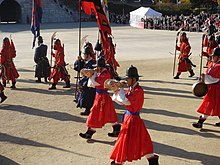
Back Corn marí Catalan Schneckenhorn German Bucio Spanish Conque French Conachag (ionnsramaid) Scots/Gaelic קונכייה (כלי נשיפה) HE Trompet kerang ID ខ្យងស័ង្ខ Cambodian ശംഖ് (വാദ്യം) Malayalam Buri Malay
 | |
| Brass instrument | |
|---|---|
| Other names | conque, seashell horn, shell trumpet |
| Classification | Natural trumpet |
| Hornbostel–Sachs classification | 423.11 (Conches) |
| Inventor(s) | Prehistoric |
| Volume | High |
| Playing range | |
| Limited, typically only a few notes | |
| Related instruments | |


Conch (US: /kɒŋk/ konk, UK: /kɒntʃ/ kontch[1]), or conque, also known as a "seashell horn" or "shell trumpet", is a wind instrument that is made from a conch, the shell of several different kinds of sea snails. Their natural conical bore is used to produce a musical tone. Conch shell trumpets have been played in many Pacific Island countries, as well as South America and Southern Asia.[2]
The shells of large marine gastropods are blown into as if it were a trumpet, as in blowing horn. A completely unmodified conch may be used, or a mouth hole may be created. Wooden, bamboo, or metal mouthpieces may be inserted into the end of the shell.[3] Embouchure is used to produce notes from the harmonic series. A tone hole may be added to change the fundamental frequency but globally this is extremely rare.[4]
Various species of large marine gastropod shells can be turned into "blowing shells", but some of the more commonly used species include triton ('trumpet shell'), cassis ('helmet shell') and strombus ('true conch')."[3]
- ^ Wells, J. C. (2016). Sounds Fascinating: Further Observations on English Phonetics and Phonology. Cambridge University Press. p. 11. ISBN 978-1-107-15779-8.
- ^ Hopkin, Bart (1996). Musical Instrument Design: Practical Information for Instrument Making Archived 2023-12-18 at the Wayback Machine, unpaginated. See Sharp. ISBN 9781884365836.
- ^ a b Herbert, Trevor and Wallace, John; eds. (1997). The Cambridge Companion to Brass Instruments, p.11-3. Cambridge University. ISBN 9780521565226.
- ^ Braun, Joachim (2002). Music in Ancient Israel/Palestine: Archaeological, Written, and Comparative Sources, p.181. Cites Hedley (1922) for this claim. Wm. B. Eerdmans. ISBN 9780802844774.